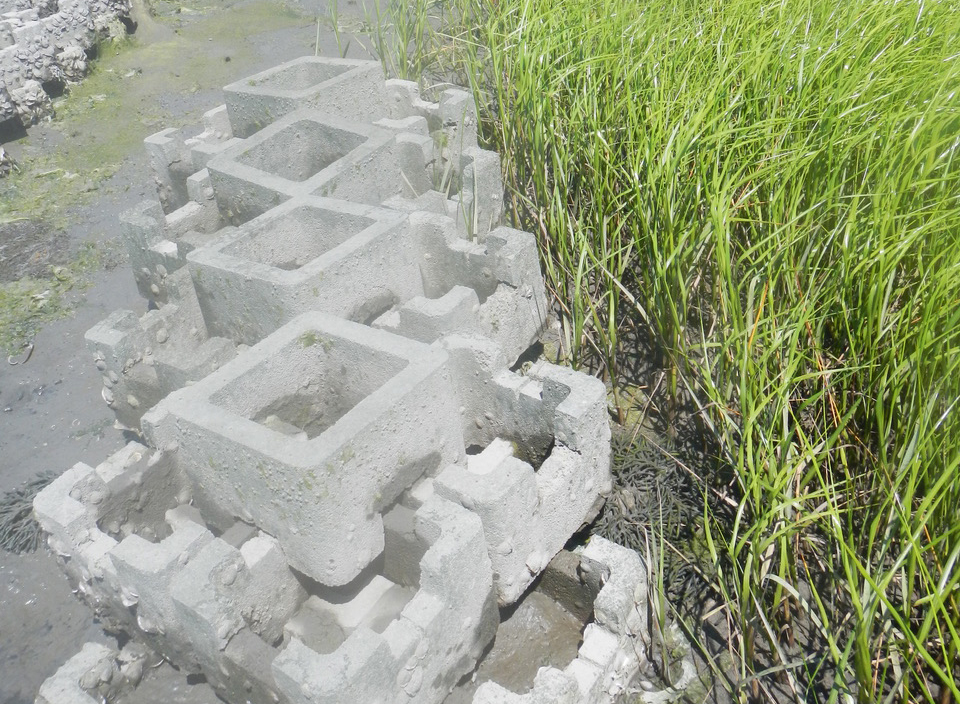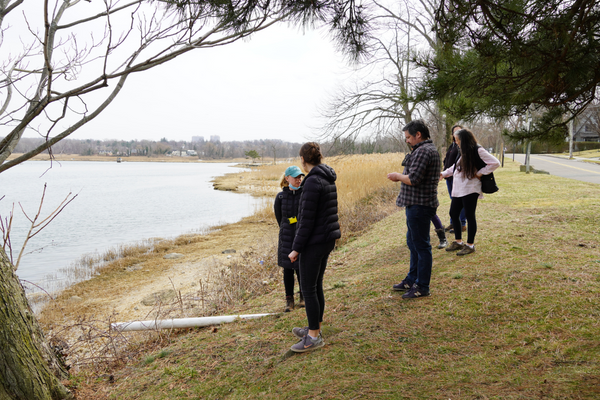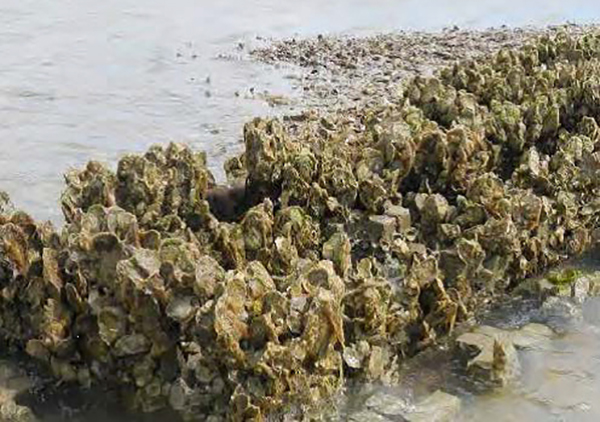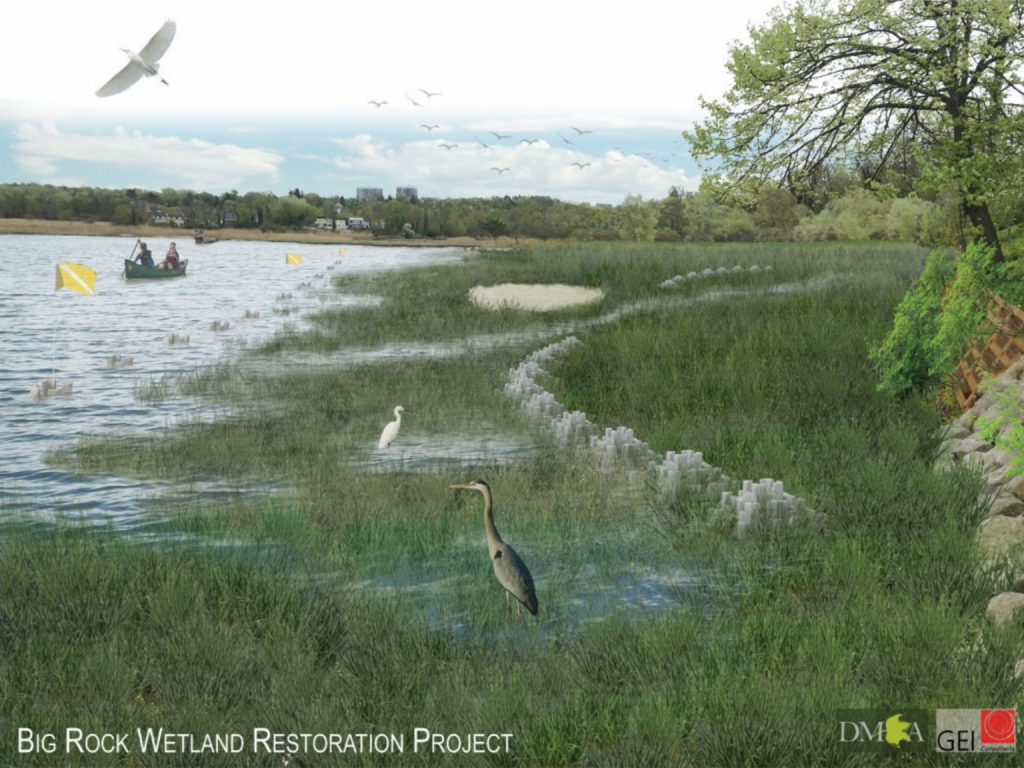
This blog post was written by Save the Sound communications intern, Jillian Hooey.
To preserve the health of the Sound, scientists are focusing on the prospective power that mussels and oysters hold to clean our waterways.
A single mussel or oyster can filter up to 50 gallons of water a day. That is almost 20,000 gallons of murky water naturally purified in one year, by a single organism. For Long Island Sound waterways in peril, these bivalves pose a promising potential solution.
Save the Sound is passionate about the prospect of partnering with unusual allies– oysters and mussels–to clean our waters and protect our coasts, specifically through our living shorelines program. With the aid of grants from various agencies and foundations, this living shoreline initiative, known as “the Big Rock Wetlands Restoration,” is projected to come to physical fruition in Douglas Manor, Queens in 2025.
So, what is a living shoreline, you ask? Living shorelines might be the first step in resolving many of Long Island Sound’s plights: erosion, water pollution, habitat deterioration, human overdevelopment, and more.
They are “nature-based features which may include plantings of native grasses, shrubs, oyster reef habitats, and bundles of wood,” as described by our New York ecological restoration program manager, Katie Friedman. We choose natural features over hard structures made of unnatural materials, like seawalls and bulkheads, which contribute to erosion in neighboring coastal areas and prevent the flourishing of ecosystems.

These living shorelines installations will, on top of providing erosion control and reducing excess levels of suspended sediment, encourage the presence of aquatic life.
Each part of the living shoreline can be used as a home by various aquatic animals. The artificial reef habitats, called “oyster castles,” used in the Big Rock project will provide a home for organisms like oysters, mussels, barnacles, and sea anemones. Artificial reefs in New York State date back to the mid-1920s when butter tubs half-filled with concrete were intentionally sunk in the Great South Bay in the interest of improving the area’s fishing success.
Now, mussel and oyster species that establish around the oyster castles will be a key part of these projects’ efforts to restore water health. The list of problems faced by the Sound feels insurmountably long: erosion, habitat loss, garbage pollution, toxins like mercury and PCBs, excess nitrogen, and more. There’s actionable hope available though, found in our armored and filter-feeding bivalve friends. An ecosystem assessment by the National Oceanic and Atmospheric Administration (NOAA) revealed that bivalves are promising fighters for tackling these issues.

Their report concluded that LIS “water quality conditions would be improved by expansion of shellfish aquaculture.” Their models, based on 25 acres of aquaculture boxes in Long Island Sound, filtered 300 billion cubic feet of water per year.
That is more than one-tenth of the estimated volume of water in LIS. The efficiency of these tiny organisms is incredibly impressive, and their potentially vital role in purifying our waters is why scientists and conservationists have an interest in employing mighty mollusks to mend the Sound.
One problematic presence in the Sound’s waters is excess nitrogen (from sources like sewage discharge and fertilizers in runoff), which stimulates excessive algae growth. The resulting algal blooms block the sun from submerged aquatic organisms and plants that rely on its rays. Not only does the algae steal their sunlight, but once it begins to decompose, it can also deplete the dissolved oxygen that fish, crustaceans, and other aquatic life need to survive.
Other pollutants in the Sound can also negatively affect human health. Toxins from common chemicals like oils, pesticides, paints, and more run off into our water, are ingested by aquatic organisms, and, by a process called biomagnification, may become more concentrated as they move up the food chain. Once a fish reaches our plate, its fat and tissue may be highly concentrated with chemicals that risk various health problems.
The good news is that mussels and oysters reduce the concentration of these toxins in our water. By incorporating them into their shells and tissues and shaping them into small packets which are deposited on the bottom of the sea, these bivalves reduce the threat of harmful chemicals in the Sound.
Katie Friedman outlined other benefits of living shorelines, sharing that “marshes and oyster reefs provide habitat for local wildlife and help improve water quality and clarity, and vegetation components pull carbon from the atmosphere and ocean as they photosynthesize.”

In three weeks, we will be celebrating the one-year anniversary of New York’s governor signing Bill S5186A into law. This forward-thinking bill, which was the top priority for our New York advocacy team for several years, requires the NYS Department of Environmental Conservation to “authorize and encourage the use of nature-based solutions as the preferred alternative for stabilizing tidal shorelines” opening pathways for more living shorelines to benefit the health of Long Island Sound’s waters.
Save the Sound reports on this health with our biennial Long Island Sound Report Card, which assesses water quality data from bays and harbors around the Sound and its open waters, with some sites receiving poor or failing grades. We are working hard to improve water quality at beaches, harbors, and bays around the Sound, with extra help from mussels and oysters on their castles under the tide.
Their eco-concrete, castle homes also absorb wave energy during storm surges and help prevent erosion, stabilizing our shorelines. Innovative nature-based solutions like these are considerate of animals by creating additional homes for them, with the added benefit of a healthier coastline for everyone.
We begin to see that the implementation of living shorelines along our coasts would begin to solve, the “insurmountable” list of issues threatening the Sound. Our organization is working to ensure that this strategy becomes a reality.
The living shorelines project at “Big Rock” is made possible through grants from the National Fish and Wildlife Foundation’s Long Island Sound Futures Fund and National Coastal Resilience Fund, US EPA’s Community Grants Program, and New York State Department of Environmental Conservation’s Water Quality Improvement Program.
We are also grateful for our project partners: Douglas Manor Environmental Association, Douglas Manor Association (landowner), Udall’s Cove Preservation Committee, Hofstra University, NYC Bird Alliance, Billion Oyster Project, and NYC Parks.
